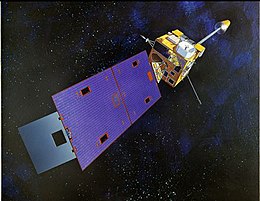 Artist's impression of a GOES-I series satellite in orbit | |
| Mission type | Weather satellite |
|---|---|
| Operator | NOAA / NASA |
| COSPAR ID | 1994-022A |
| SATCAT no. | 23051 |
| Mission duration | 3-5 years (planned) 10 years (achieved) |
| Spacecraft properties | |
| Bus | LS-1300 |
| Manufacturer | Space Systems/Loral |
| Launch mass | 2,105 kilograms (4,641 lb) |
| Start of mission | |
| Launch date | 13 April 1994, 06:04 UTC |
| Rocket | Atlas I |
| Launch site | Cape Canaveral LC-36B |
| Contractor | Martin Marietta |
| End of mission | |
| Disposal | Decommissioned |
| Deactivated | 5 May 2004 |
| Orbital parameters | |
| Reference system | Geocentric |
| Regime | Geostationary |
| Longitude | 75° West |
| Slot | GOES-EAST (1995-2003) |
| Eccentricity | 0.0005384 |
| Perigee altitude | 36,151 kilometres (22,463 mi) |
| Apogee altitude | 36,197 kilometres (22,492 mi) |
| Inclination | 10.89° |
| Period | 1,456.0 minutes |
GOES-8, known as GOES-I before becoming operational, was an American weather satellite, which formed part of the US National Oceanic and Atmospheric Administration's Geostationary Operational Environmental Satellite system. It was launched in 1994, and operated until 2004 when it was retired and boosted to a graveyard orbit.[1][2] At launch, the satellite had a mass of 2,105 kilograms (4,641 lb), and an expected operational lifespan of three or five years.[3][4] It was built by Space Systems/Loral, based on the LS-1300 satellite bus, and was the first of five GOES-I series satellites to be launched.
- ^ "GOES-NEWS". NASA. 2009-05-09. Archived from the original on 2004-06-05. Retrieved 2009-07-13.
- ^ "GOES-8 Spacecraft Status Summary". NOAA. Archived from the original on 2006-08-18. Retrieved 2009-07-13.
- ^ Krebs, Gunter. "GOES-8, 9, 10, 11, 12". Gunter's Space Page. Retrieved 2009-07-13.
- ^ Cite error: The named reference
Statuswas invoked but never defined (see the help page).